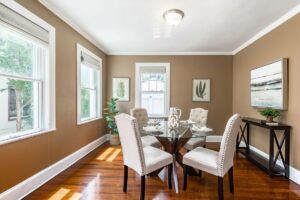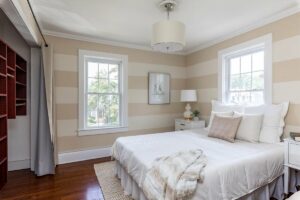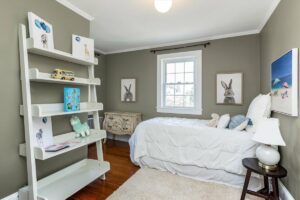Staging A Home Before Selling
When buyers look at many potential homes, they usually try to visualize themselves in it. If they can’t picture themselves living there, they’re not going to be as excited to buy the home. The sales price of a home is maximized when buyers become emotional. The effect can be created by staging the home. People perceive a house by the decor and furniture, it can bring rooms to life and hide any imperfections or flaws a room may have.
Staged homes have increasingly become popular within recent years and have been proven to have a better appeal to potential buyers. Staging your home may be a lot of effort, but it’s worth it, they’re known to sell faster and for more money than those that are unstaged.
What is Staging?
Staging is the process of hiring a company which has a background in interior design and inventory of furniture that can be rented and strategically placed to make a home appear to be move-in ready. The interior is designed to create a certain look and feel for the rooms in the house. Most staged homes are designed with furniture, art, paintings, lights, plants, rugs, books, table decor and more. Most staging techniques and strategies are focused primarily on appearance as it creates a more welcoming environment for potential buyers instead of showing them empty rooms.
Benefits of Staging
There are many benefits when it comes to staging your home. Most buyers view a home for the first time online and photos of a staged home will definitely create a better viewing experience than a home that is not staged. Since there are many listings online, you should want yours to stand out and be well presented. That’s where professional staging and photographs come in to play.
When a home is staged to appeal to current trends, it improves not only the appearance and atmosphere, it also emphasizes special features of the house. You may not be appealing to buyers’ interests if you use previously owned furniture that has been left in its original positioning or a home that is primarily empty.
Staging can also benefit any smaller rooms or odd shaped rooms you have within the house. With strategic staging, you can make the room show function, have a purpose and give ideas to potential buyers how they could use that room. When staged properly, potential buyers should have no questions about the purpose of the room and see the possibilities and function.
Not only does staging make each room have a purpose, it also makes some rooms appear to be larger. All clutter is removed and furniture is arranged in a way that maximizes the usable space within the house. It gives the impression that the house is larger than it actually is. You never want buyers to get the impression that the house is cramped and crowded.
Potential buyers are more attracted to staged houses because people like to buy on emotion, it makes it easier for them to picture themselves living there. The moment a buyer is imagining themselves in it, the higher likelihood that the offer will be higher than it would have been.
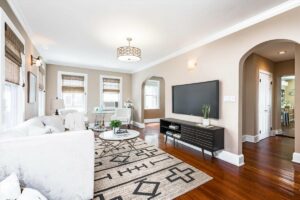
Staging & Time on the Market
Staging a house can also greatly decrease the time that it is on the market. The Real Estate Staging Association (RESA) reports that unstaged homes on average sell in 143 days, compared to staged homes which sell in around 40 days. Any home that was staged prior to when the listing went on the market sold in an average of 23 days. If a staged home helps your home sell quickly, it also means it will save you money from holding costs being reduced.
We are living in a sellers market. There’s not enough houses on the market and too many buyers looking to purchase. Homes are already in heavy demand, and the ones that stand out will gain even more attention, which in turn will lead to more offers and a higher than expected sales price.
The Effects on Sales Price
As much as staging decreases the time a house is on the market, it also helps increase the price people will be willing to pay for the house. According to the National Association of Realtors, “71 percent of sellers’ agents believe a well-staged environment increases the dollar value buyers are willing to offer.”
Homebuyers today are knowledgeable when it comes to property values. Many potential buyers will analyze the asking price thoroughly. But if the home is staged, it makes it easier to justify the price.
The condition of the home ultimately will increase or decrease the sales price. If potential buyers do a walk through of a house and they see a number of flaws or repairs that need to be made, they may question the asking price. If they see a house perfectly designed and appears to be move-in ready that doesn’t need a lot of work done, they’re more likely to offer the asking price or bid above
The National Association of Realtors states, “that you can get 4x a return on what you invest on staging your home,” it’s well worth your time putting this investment in when selling something as expensive as your home.
With so many homes being sold at asking price or above, appraisals have also become a concern. Staging the home should also help justify the contract price when the bank comes to value it and compare it to other similar sales in the area.
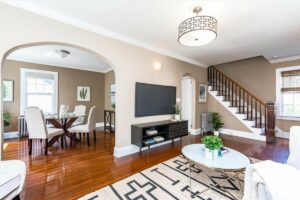
The Cost of Staging
The cost of staging a home depends on a few factors. Some stagers charge by the hour and some charge a set fee. Most of the time, the price is higher or lower depending on the size of the home and scope of work. If all of the rooms are staged, the cost will be higher than if only a selection of the home is staged.
Virtual staging is also an option for those that can not afford physical staging. In virtual staging, furniture and accessories are photoshopped into the rooms. Two photos should always be presented (one staged and one original) so that the buyers will see the vision and possibilities if they renovated the room and bought similar furniture. This option is cheaper than physical staging but once the buyers view the home in real time, they will not see the furniture and it could be detrimental.
DIY Staging
There’s always the option of staging the house without hiring a professional. Sometimes a home is occupied and a full set of furniture cannot be brought into the home. The pre-existing furniture can be used in some situations and moved around to create a better flow. If this route is chosen, these are some tips:
- Manage clutter and get rid of any extra furniture
- Group furniture together away from walls
- Transform any rooms that are only used to collect clutter to something that has more of a purpose and function
- Make sure the rooms are well-lit
- Paint the walls of the home a neutral, soft color
- Stagger wall hangings
- Accessorize
- Give the bathrooms a primed and polished look
When putting a house on the market, a seller will want to sell it fast and for the best price. In order to achieve this, staging has been a tried and proven way to present a home in the best possible light.
